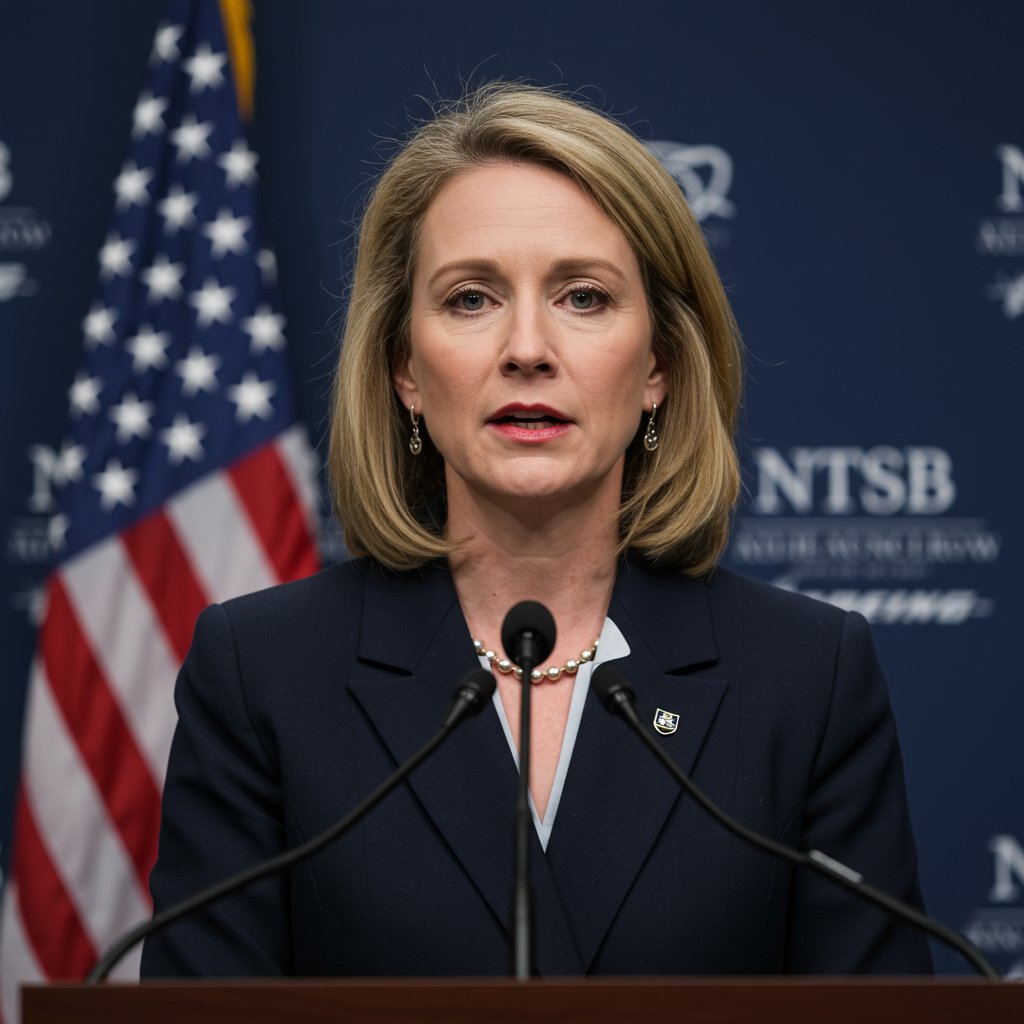The shocking incident where a door plug detached mid-flight from an Alaska Airlines Boeing 737 Max 9 aircraft in January 2024 was the result of “multiple system failures,” according to the National Transportation Safety Board (NTSB). Following a 17-month investigation, the NTSB has explicitly placed blame on both aircraft manufacturer Boeing and the Federal Aviation Administration (FAA) for the near-catastrophic event.
NTSB Chair Jennifer Homendy stated at a public meeting that an accident like this only happens when there are fundamental breakdowns across multiple systems. The board concluded that the safety deficiencies leading to the blowout were preventable and should have been obvious to both Boeing and the FAA.
The Immediate Cause: Four Missing Bolts
The investigation determined the most direct cause of the door plug separating was the absence of four critical bolts designed to secure the panel to the aircraft fuselage. These bolts, known as vertical movement arrestors and guide track bolts, prevent the plug from moving vertically and dislodging.
Investigators discovered that these bolts had been removed during repairs to damaged rivets near the door plug on the aircraft while it was still at the Boeing factory. Crucially, evidence from photo documentation obtained by the NTSB showed the door plug reinstalled without the bolts. Analysis confirmed none of the four bolts were in place when the plane left the factory. Engineering evaluations supported the finding that even the proper installation of just one lower bolt or both upper bolts could have prevented the plug separation during flight.
Despite extensive efforts, investigators were unable to identify the specific individuals responsible for failing to reinstall the missing bolts.
Boeing’s Manufacturing Failures Under Scrutiny
The NTSB report pointed to significant issues within Boeing’s manufacturing processes as a primary contributing factor. Investigators found a failure in Boeing’s system designed to document the removal and reinstallation of parts during rework. Paperwork that should have triggered required inspections after the door plug removal was never created.
Beyond the procedural lapses, the investigation revealed broader systemic problems at Boeing’s Renton, Washington, factory where the aircraft was manufactured. NTSB found that factory workers felt pressured to work too quickly, were sometimes assigned tasks they were unqualified for (including handling this specific type of door plug), and lacked adequate training, particularly newer hires brought on post-pandemic and after previous 737 Max crashes. Documentation standards were found to be poor, and a more rigorous safety plan required after a 2015 settlement was not effectively implemented throughout the company.
NTSB Chair Homendy characterized the incident not as simple human error by one or two individuals, but fundamentally a “process issue, a process failure,” arguing the entire system relied too heavily on human compliance without adequate checks and balances.
FAA Oversight Falls Short
The NTSB also concluded that the FAA shared blame for contributing to the accident through ineffective oversight. The safety board faulted the FAA’s “ineffective compliance enforcement surveillance and audit planning activities,” which failed to adequately identify and ensure that Boeing addressed repetitive manufacturing problems related to its parts removal process.
Investigators found that the FAA’s audit standards were not clear and that the agency routinely discarded past inspection records after five years, hindering its ability to base future inspection plans on historical findings and systemic issues at the manufacturer.
The Incident Unfolds
The incident occurred on January 5, 2024, just six minutes after Alaska Airlines Flight 1282 took off from Portland, Oregon, bound for California. At approximately 16,000 feet over Oregon, the 2-foot-by-4-foot mid-exit door plug suddenly blew outward, leaving a gaping hole in the side of the aircraft.
The sudden decompression created a terrifying roar and a vacuum that sucked objects out of the cabin. While there were 177 people on board, and eight individuals (seven passengers and one flight attendant) sustained minor injuries, the outcome could have been far worse. Investigators noted that the two seats immediately adjacent to the opening were unoccupied, and Alaska Airlines had proactively restricted the aircraft to overland flights due to another maintenance issue, which prevented it from flying over open water where an emergency landing would be more difficult. The flight crew performed heroically, successfully executing an emergency landing back in Portland.
A passenger on the flight, Shandy Brewer, described the terrifying experience: “All of a sudden, just this huge bang happened… As soon as I step onto an airplane, tears start pouring down my face every single time.”
Responses and Recommendations
In the wake of the NTSB’s findings, both Boeing and the FAA issued statements.
Boeing expressed regret for the accident and stated it is working on strengthening safety and quality across its operations, pledging to review the report and recommendations. The company had previously indicated plans for a design change to make the door plug more secure and retrofit existing planes.
The FAA stated it is taking the NTSB’s recommendations seriously and has fundamentally changed its oversight of Boeing since the accident, implementing aggressive monitoring, including weekly meetings and increased targeted audits and inspections at Boeing facilities. The agency emphasized it has not lifted the production cap placed on the 737 Max line until it is confident Boeing can maintain safety and quality standards.
Alaska Airlines stated it looks forward to reviewing the final report and remains committed to safety as its highest priority.
U.S. Transportation Secretary Sean Duffy criticized the prior administration and Boeing for having “taken their eye off the ball,” vowing that under the current administration, safety is paramount.
The NTSB issued several new safety recommendations, primarily directed at the FAA. These include:
Revising FAA systems for compliance enforcement surveillance, audit planning, and record retention (retaining records older than 5 years).
Developing guidance and providing recurrent training to FAA managers and inspectors.
Convening an independent third-party panel to conduct a comprehensive review of Boeing’s safety culture.
Significantly, the NTSB urged Boeing and Spirit AeroSystems (which manufactured and installed the plug) to expedite the redesign of the door plug to include a backup system that would prevent separation even if primary bolts are missing. They also recommended the FAA certify this change and ensure all existing 737 Max jets are retrofitted, although certification for a redesigned plug is not expected until 2026 at the earliest.
Looking Ahead: Lawsuits and Safety Culture
The incident has led to legal action. Shandy Brewer is among a group of 35 passengers who have filed a lawsuit against Boeing and Alaska Airlines. Their lawyer stated the NTSB findings confirm their suspicion of “woefully sloppy” quality control at Boeing and FAA failure as a watchdog.
Despite the severe findings regarding manufacturing processes and oversight, NTSB Chair Homendy reiterated her overall confidence in the safety of Boeing airplanes but stressed the critical need for implementing improvements to close remaining safety gaps.
The NTSB’s final report, including formal recommendations, is expected in the coming weeks. Meanwhile, the focus remains on ensuring the systemic failures identified are truly addressed to prevent future incidents and restore confidence in air travel safety. The revelation that other airlines like United Airlines subsequently found loose bolts on their 737 Max 9 fleets underscores the potential for these issues to extend beyond a single aircraft.




